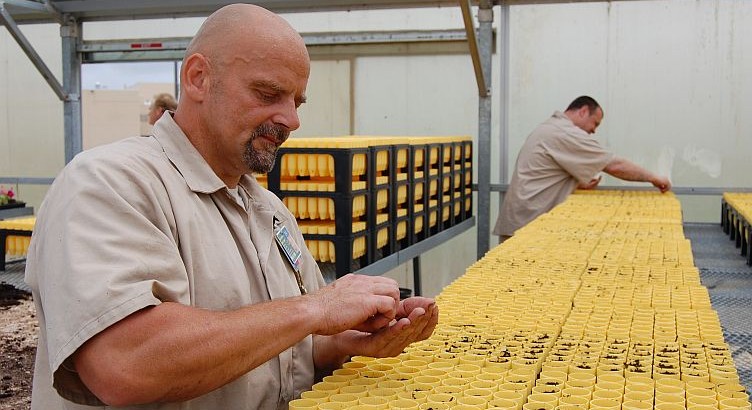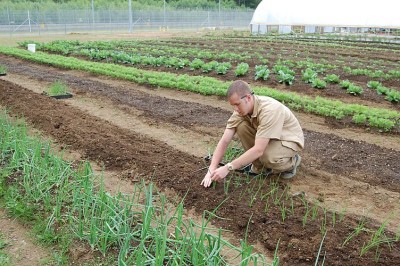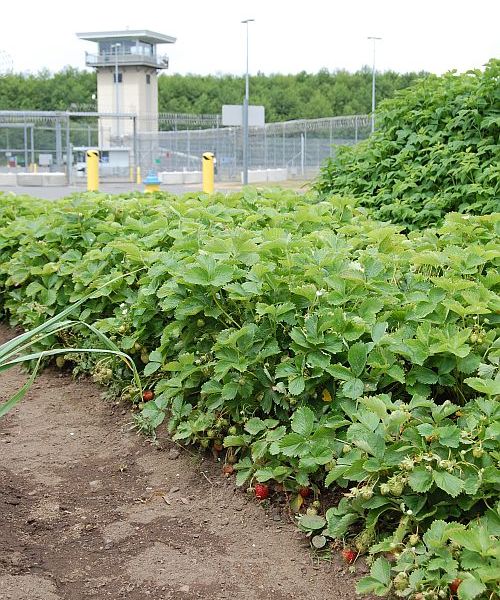 Daniel plants showy fleabane, a prairie flower native to the Pacific Northwest, at the Stafford Creek Corrections Center.Photo: Sarah van Schagen
Daniel plants showy fleabane, a prairie flower native to the Pacific Northwest, at the Stafford Creek Corrections Center.Photo: Sarah van Schagen
Rows and rows of small yellow cylinders fill the greenhouse where Daniel works steadily, beads of sweat forming on his round, bald head as he places tiny seeds in each container. He is planting showy fleabane, an endangered variety of prairie groundcover that will eventually produce purple-petaled blooms worthy of their moniker.
His work is part of a federally funded prairie restoration project, an effort to repair the native grasslands of the Pacific Northwest in areas like Fort Lewis, Wash. But Daniel, who asked that his last name not be used, is not your average horticulturalist. For one thing, his greenhouse is on the grounds of a maximum security prison.
Daniel, as well as many of the men tending seedlings around him, is part of the Sustainable Prisons Project at the Stafford Creek Corrections Center in western Washington. The program is a partnership between Evergreen State University and several state correctional facilities that allows offenders to opt in to sustainability-related work projects.
 Jason Chandler plants Walla Walla Sweet Onions in the organic garden at Stafford Creek Corrections Center.Photo: Sarah van SchagenThe liberal-arts university/state penitentiary partnership may sound like an odd pairing — the Evergreen alumni magazine likened it to Maya Angelou dating Dick Cheney — but so far, both parties consider the relationship a success. The scientists get cheap (and eager) labor, while the offenders get the opportunity to participate in meaningful work.
Jason Chandler plants Walla Walla Sweet Onions in the organic garden at Stafford Creek Corrections Center.Photo: Sarah van SchagenThe liberal-arts university/state penitentiary partnership may sound like an odd pairing — the Evergreen alumni magazine likened it to Maya Angelou dating Dick Cheney — but so far, both parties consider the relationship a success. The scientists get cheap (and eager) labor, while the offenders get the opportunity to participate in meaningful work.
One inmate participating in the pilot program at the Cedar Creek Corrections Center was the senior author of a peer-reviewed paper about the project in an international sustainability journal, and upon his release began pursuing a Ph.D. in biochemistry.
“What I care about is that [the offenders] are exposed to what we can offer in the way of science, the wonder of nature, of thinking critically,” says Nalini Nadkarni, the Evergreen ecologist who helped establish the Sustainable Prisons Project. “Those are all things that when they get back out into society, they will carry with them … increas[ing] the scientific literacy of our country, and perhaps even more important … the civic engagement that they have with society.”
The tasks vary across the four prisons that are now part of the sustainability project (administrators hope eventually to expand it statewide), and include tending to organic gardens that provide fresh produce for the kitchen, separating recyclables from the waste stream, beekeeping, and minding composting worms.
The offenders can also participate in a variety of conservation efforts like the prairie restoration, a project being led by The Nature Conservancy. They are also helping breed endangered spotted Oregon frogs and “farm” mosses for the horticultural trade (which aids in preventing unsustainable harvesting from old-growth forests).
 Photo: Sarah van SchagenAll of the offenders involved in the program get specialized training and guidance from scientists and other educators working with the corrections centers.
Photo: Sarah van SchagenAll of the offenders involved in the program get specialized training and guidance from scientists and other educators working with the corrections centers.
That green-collar job training is key, says Doug Raines, the man behind Stafford Creek’s new beekeeping operation. He knows there are lots of valid reasons to keep bees — honey production, pollination, protection from colony collapse — but he does it to provide job opportunities.
“If I can get one guy a job and he doesn’t come back, then I have paid for everything that we have done, and that’s my reason for having the bees,” Raines says. “It’s one more avenue for employment when they get out of here.”
The offenders aren’t the only ones at the correctional facilities who are benefitting from the project, though. The sustainability efforts are also saving money — a valuable incentive in an economy that has seen significant cuts to the state’s Department of Corrections budget.
When the Cedar Creek facility began to tap out its water supplies, efficiency upgrades like low-flow toilets and showers and a rainwater catchment system helped save 250,000 gallons of water in the summer alone. And the gardening, composting, and recycling efforts are saving the facilities thousands of dollars every year.
“[Correctional facilities] are essentially small cities running 24/7,” says Sustainable Prisons Project Manager Jeff Muse. “If we can make them more sustainable, not only will it save money, save natural resources, and save lives, but it would be an example for all kinds of other institutions, such as military bases, summer camps, hospitals, and schools.”




